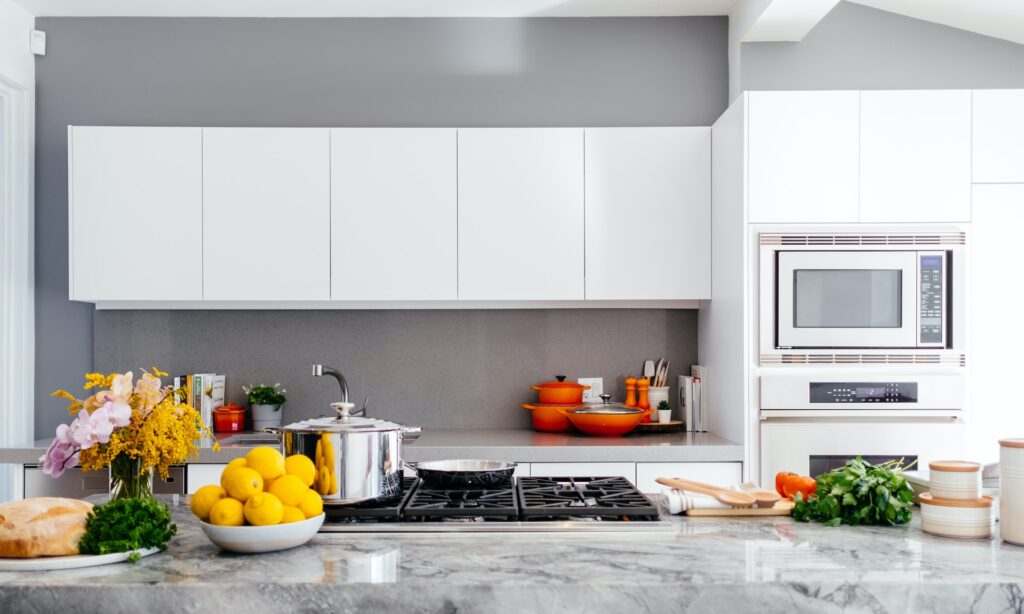Among the most popular kitchen accents these days are the countertops. And among the most preferred material options for kitchen countertops is the natural stone. The natural stone countertops look stylish and expensive and at the same time they are practical and functional. Most often, for the production of stone countertops, slabs of granite or marble are used. Granite is the stronger material and is very often used for countertops even in professional kitchens. Marble is somewhat inferior in terms of strength, but it also has its advantages – for example, in contact with water, it forms an alkaline environment, which prevents the development of bacteria.
Granite countertops
Granite kitchen countertops are an expensive element of kitchen design, but they pay off with their strength and durability, and they easily fit into almost any interior. Granite has unique natural patterns – fine or coarse-grained – and the color of the stone can vary from very light to black. Due to its natural colors, granite looks good in combination with metal and wooden interior elements. As a rule, the thickness of a natural granite slab used as a countertop varies from 3 to 5 cm (1.5 to 2 inches) and can be shaped differently – oval, rectangle or asymmetrical. In terms of surface treatment, there is also a choice of different types depending on preferences and interior style – polished, matte, edged (for a more retro look), heat treated.
The main advantage of granite is its high strength. The material is difficult to scratch or damage, even if you cut your food without a cutting board or put hot dishes on it – granite perfectly withstands both high and low temperatures and mechanical stress. Like everything, it also has its drawbacks:
- Complex replacement of countertop parts – if a part of the surface is damaged, it is almost impossible to find a replacement, since every natural granite slab has a unique shade and pattern.
- High price – the fabrication and installation of a granite kitchen countertop is really expensive.
- Heavy weight – granite is a heavy stone and its use as a countertop requires a stable and quality base.
When choosing a granite slab for a kitchen countertop, make sure that the surface is resistant to liquids and dirt without becoming stained. In this case, it is best to choose a plate with a polished surface. Also make sure you have transportation and installation options, either from the stone supplier or another contractor, as the heavy weight of granite often requires special equipment. It is also good to know that manufactured stone granite slabs (a mixture of granite particles and polymers) are also available on the market.

Photo by Jason Briscoe on Unsplash
Marble countertops
Marble countertops easily fit in both modern and classic kitchen interiors. This stone goes well with various materials – wood, metal, ceramics and even plastic. The natural pattern of the marble makes every countertop unique. Like granite slabs for kitchen countertops, marble also comes in several varieties of surface – polished, matte and antique finish – etched or brushed, etc. Polished marble is more resistant to dirt and more versatile. It fits well into almost any interior – from baroque to hi-tech. The matte stone has a silky feel to the touch and a muted color. Such a stone is often used in country-style interiors. However, with such treatment, the pores on the surface of the stone make it more susceptible to contamination. Scratches, fingerprints and even small chips are not visible on etched or brushed marble. The thickness of the marble slab should be about 3 cm (1.5 inch).
Among the many benefits of marble kitchen countertops are:
- Unique colors and patterns – shades of stone can be different and successfully emphasize the natural structure of marble.
- Ecological and hypoallergenic – this natural stone is safe and even antibacterial – in contact with water, it forms an alkaline environment, which prevents the development of bacteria.
- Robust and resistant to damage – although not quite as strong as granite, marble is also an extremely durable material for kitchen countertops.
- Easy processing – you can easily relate the look of your countertop by polishing it.
Of course, marble also has its drawbacks:
- Marble is sensitive to sudden changes in temperature – the stone is fragile, and when exposed to high temperatures, the surface may crack.
- Porosity of the material – stains easily remain on it, which are extremely difficult to remove.
Whichever of the two types of materials you choose for your new natural stone kitchen countertop, you will hardly go wrong – both granite and marble will bring style and beauty to your kitchen interior, and with a little attention to them, you will use your countertop for a long time. Of course, you can also choose other natural stone options – quartz, onyx and others, as well as various manufactured stone alternatives.

Comments